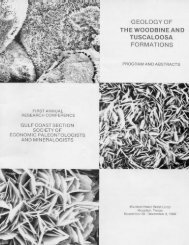Petroleum Systems of Deep-Water Basins - Gulf Coast Section SEPM
Petroleum Systems of Deep-Water Basins - Gulf Coast Section SEPM
Petroleum Systems of Deep-Water Basins - Gulf Coast Section SEPM
You also want an ePaper? Increase the reach of your titles
YUMPU automatically turns print PDFs into web optimized ePapers that Google loves.
SEAMAGIC or How to SAMBA in South East Asia:<br />
Reservoir and <strong>Petroleum</strong> System Controls,<br />
a Tectonic Recompilation and Prospectivity Analysis<br />
William G. Dickson<br />
DIGs<br />
12503 Exchange Drive, Suite 510A<br />
Stafford, Texas 77477<br />
e-mail: info@digsgeo.com<br />
Janice M. Christ<br />
J-SEA Geoscience<br />
3 Biscay Court<br />
The Woodlands, Texas 77381<br />
e-mail: janchrist@usa.net<br />
James W. Granath<br />
Granath & Associates<br />
14102 Langbourne Drive<br />
Houston, Texas 77077<br />
e-mail: granath@attglobal.net<br />
Mark E. Odegard<br />
Getech (Geophysical Exploration Technology, Inc.)<br />
12946 Dairy Ashford, Suite 250<br />
Sugarland, Texas 77478<br />
e-mail: meo@getech.com<br />
Abstract<br />
Remarkable correlations between gravity imagery and reservoir distribution have been documented in basins <strong>of</strong>fshore<br />
Brasil and West Africa in a simple passive margin setting. The present group has tackled Southeast Asia, and its<br />
much more complicated plate history, placing the petroliferous basins in a clearer tectonic framework. We used a GIS<br />
environment to enable faster and more precise interpretation methods and digital presentation <strong>of</strong> results. First we correlated<br />
published geological features to gravity and magnetic anomalies displayed as geotiffs (geo-referenced<br />
images). We reinterpreted, realigned and extrapolated even long-recognized features not previously imaged in their<br />
entirety, due to inadequate data coverages. We refined the location and extents <strong>of</strong> many first-order tectonic features<br />
through their gravity/magnetic signatures, including the Red River, Three Pagodas and other faults, the outlines <strong>of</strong><br />
most <strong>of</strong> the Tertiary basins, and various discovery trends.<br />
Our results contrast examples from the Campos and Lower Congo basins (showing sediment distribution controls<br />
by basement faulting and salt-involved compression respectively) with both extensional and compressional regimes in<br />
Southeast Asia. In each region, potential field signatures suggested relationships that explained reservoir distribution<br />
or controls on petroleum systems. While mapping terrane boundaries, we also reinterpreted extents <strong>of</strong> continental,<br />
oceanic and proto-oceanic crust and their depths, with natural consequences for hydrocarbon maturation modeling.<br />
Side benefits <strong>of</strong> a GIS approach are: (1) the ease with which multiple data sets from participants can be integrated and<br />
updated; and, (2) improved corporate memory as the project evolves.<br />
42

















